Askania 5x20 & 20x80
| Dieses Askania Richtfernrohr,für Kinotheodoliten und ähnliches hat eine Umschaltung zwishcen einem 5x20 und einem 20x80 Fernrohr. Der untere Basis-Teil des Richtfernrohrs entspricht dem 20x80 Modell und hat eine aufsteckbare Sonnenblende sowie einen Schutzdeckel dafür. Der konische Tubus hat eine Schwalbenschwanzmontierung unten und Kimme-und-Korn Visiere links und rechts. An der Unterseite befinden sich auch die Stromkontakte für die Beleuchtung. | This Askania director telescope for cine-theodolites and the like has a switch between a 5x20 and a 20x80 telescope. The lower base part of the telescope corresponds to the 20x80 model and has an attachable sunshade and a protective cap for it. The tapered tube has a dovetail mount on its bottom and rear sights on the left and right side. The power contacts for the lighting are also located on the bottom. |
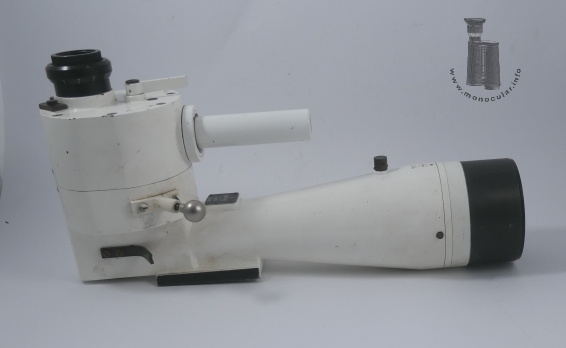
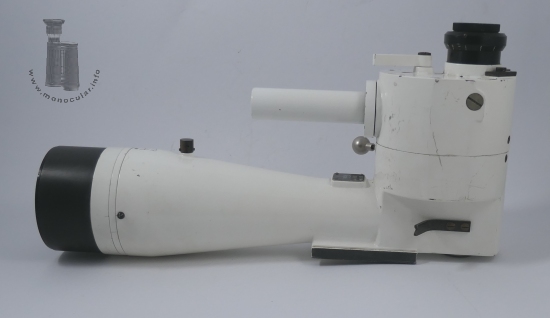

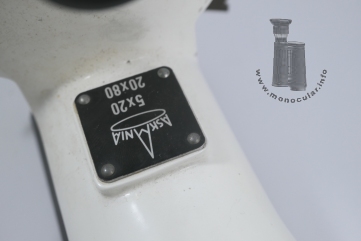
| Im Prismengehäuse ist ein Umlenkprisma, welches den Strahlengang rechtwinklig zum Okular schickt. Vor das Prisma zum 20x80 Fernrohr kann ein Graufilter mittels eines Schiebhebels geschoben werden (s. Foto). Dies ist evtl. ein extra Zusatz, den es bei anderen Exemplaren des Modells nicht gibt. Über dem Filtergehäuse befindet sich ein weiteres Gehäuse (7fach verschraubt) mit der Umschaltung zwischen 5x und 20x anhand eines Schwenkhebels auf der Gehäuseoberseite, die mit den Vergrößerungswerten gekennzeichnet ist. Beim Drehen wird ein anderes Umlenkprisma in den Strahlengang zum Okular eingeschwenkt (s. Foto). Das 5x20 hat ein abschraubbares dünneres Sonnschutzrohr. Alle bislang genannten Teile sind weiß lackiert. Auf der Gehäuseoberseite gibt es zwei eingeschruabte Halterungen für die kleine Glühbirnen, die sich durch Herausdrehen Austauschen lassen. Das schwarz lackierte Okular hat eine Fadenkreuzstrichplatte und eine Diotprienskala von + bis - 5. Die optischen Glasteiles sind blau vergütet. Am Tubus befindet sich in der Nähe des Prismgehäuses das angenietete schwarze Beschriftungsschild mit dem Askania-Logo und den Spezifikationen sowie vor der geraden Objektivfassung die Zeichen "H 834". Eine Abdeckchraube schließt evtl. den Einlass für ein Trockenluftgerät. |
In the prism housing is a deflection prism, which sends the beam path at right angles to the eyepiece. A grey filter can be slid in front of the prism of the 20x80 telescope using a sliding lever (see photo). This may be an extra feature that other examples of this models do not have. Above the filter housing is another housing (7 screws) which comes with a swivel lever switching between 5x and 20x on the top of the housing. It is marked with the magnification values. When turning that, another deflection prism is pivoted into the beam path of the eyepiece (see photo). The 5x20 has a slender sunshade that can also be unscrewed. All parts mentioned so far are painted white. On the top of the housing there are two screwed-in holders for the small light bulbs, which can be exchanged by unscrewing them. The black lacquered eyepiece has a corss-hairs reticle and a diopter scale from + to - 5. The optical glass parts are coated blue. A black label with the Askania logo and the specifications is riveted onto the tube near the prism housing. Ther are also the characters "H 834" near the straight objective lens frame. A cover screw on the main tube may work as an inlet for a dry air apparatus. |
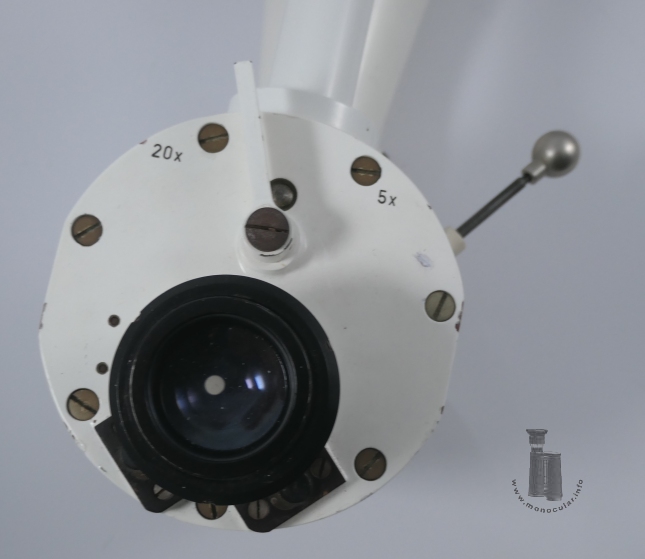
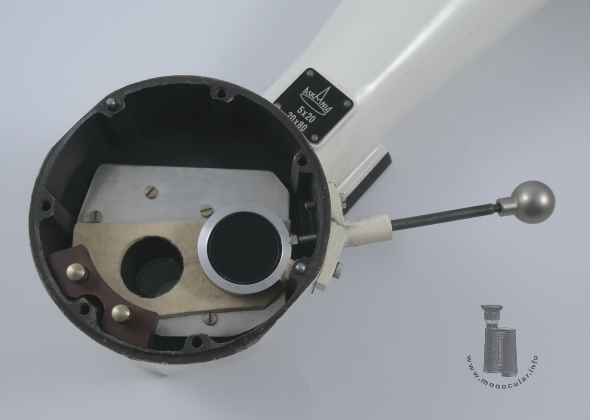
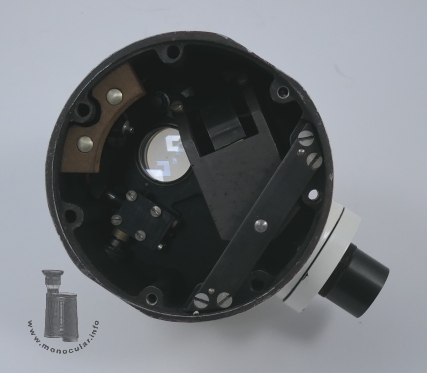
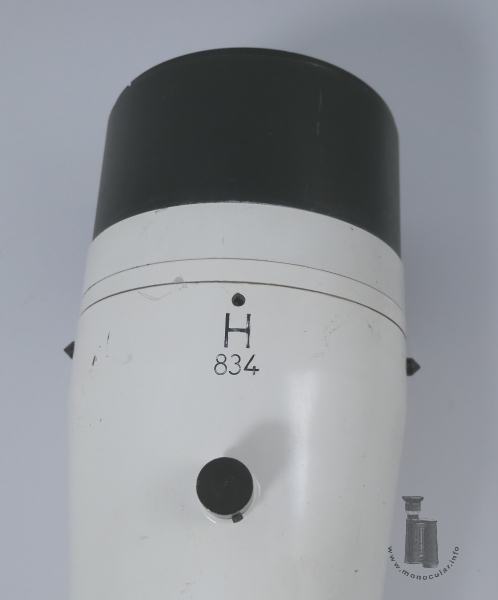
| Das Fernrohr ist 440 mm bzw. mit großer Sonnenblende und Kappe 540 mm lang. Die kleine Sonnenblende ist 120 mm lang und 31 mm im Durchmesser. Der konische Haupttubus startert bei 61 mm und endet mit 104 mm im Durchmesser. Er ist ca. 260 mm lang, mit anchließender 50 mm langer schwarz lackierter Objektivfassung. Die Bodenplatte der Schwalbenschwanzfassung misst 100 x 78 mm. Das untere Gehäuse mit Umlenkprisma ist 120 x 62 mm groß, die daran befestigten Visiere sind aus einer 65 mm langen gebogenem Metallstück (9 mm breit). Die Stromkontakt-Scheibe auf der Unterseite ist 35 mm im Durchmesser. Die beiden weiteren runden Gehäuseteile mit abgeflachten seiten sind ca. 120 mm im Durchmesser und zusammen 118 mm hoch. Der Filterhebel lässt sich bis zu 98 mm ausziehen, der Umschalthebel für die vergrößerung ist 55 mm lang. Das Okular ist 49 mm, der breite Fokussierungsring 57 mm und die geriffelte Augenmuschel 43 mm im Druchmesser. Die weiß lackierte Okular-Sockelfassung ist 54 mm im Durchmesser. Das Okular verstellt sich von 47 bis auf 52 mm in der Höhe. Das Gesamtgewicht ist4197 g, das Rcihtfernrohr selbst wiegt 3957 g, die große Sonnenblende 134 g, die Kappe 77 g, die kleine Blende 26g. | The telescope is 440 mm long, or 540 mm long with its large sunshade and cap. The small sunhade is 120 mm long and 31 mm in diameter. The conical main tube starts with 61 mm and ends with 104 mm in diameter. It is approximately 260 mm long, with an attached 50 mm long black lacquered lens frame. The bottom plate of the dovetail mount measures 100 x 78 mm. The lower housing with the deflecting prism is 120 x 62 mm. The sights attached to it are made of a 65 mm long bent piece of metal (9 mm wide). The power socket disc on the bottom is 35mm in diameter. The other two round housing parts with flattened sides are approx. 120 mm in diameter and together measure 118 mm in height. The filter lever can be pulled out up to 98 mm, the switch lever for magnification is 55 mm long. The eyepiece is 49mm, the wide focusing ring is 57mm and the knurled eyecup is 43mm in diameter. The white lacquered eyepiece socket is 54 mm in diameter. The eyepiece adjusts in height from 47 to 52 mm. The total weight is 4197g, the scope itself weighs 3957g, the large sunshade 134g, the cap 77g, the small shade 26g. |
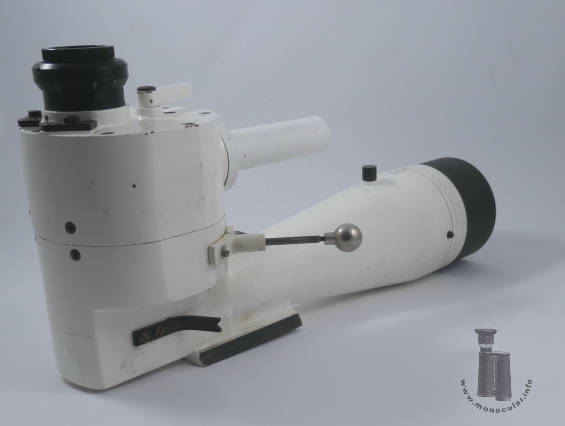
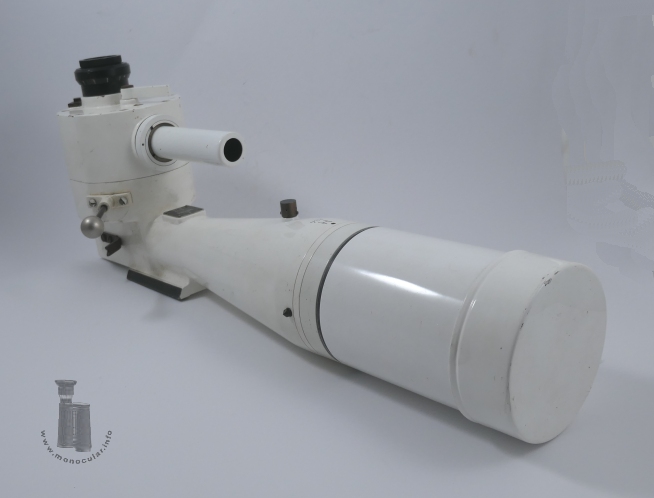
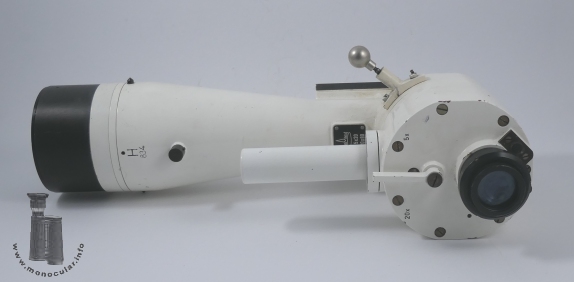
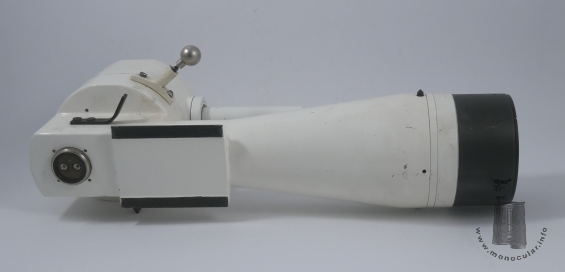
Fotos: Zeun

